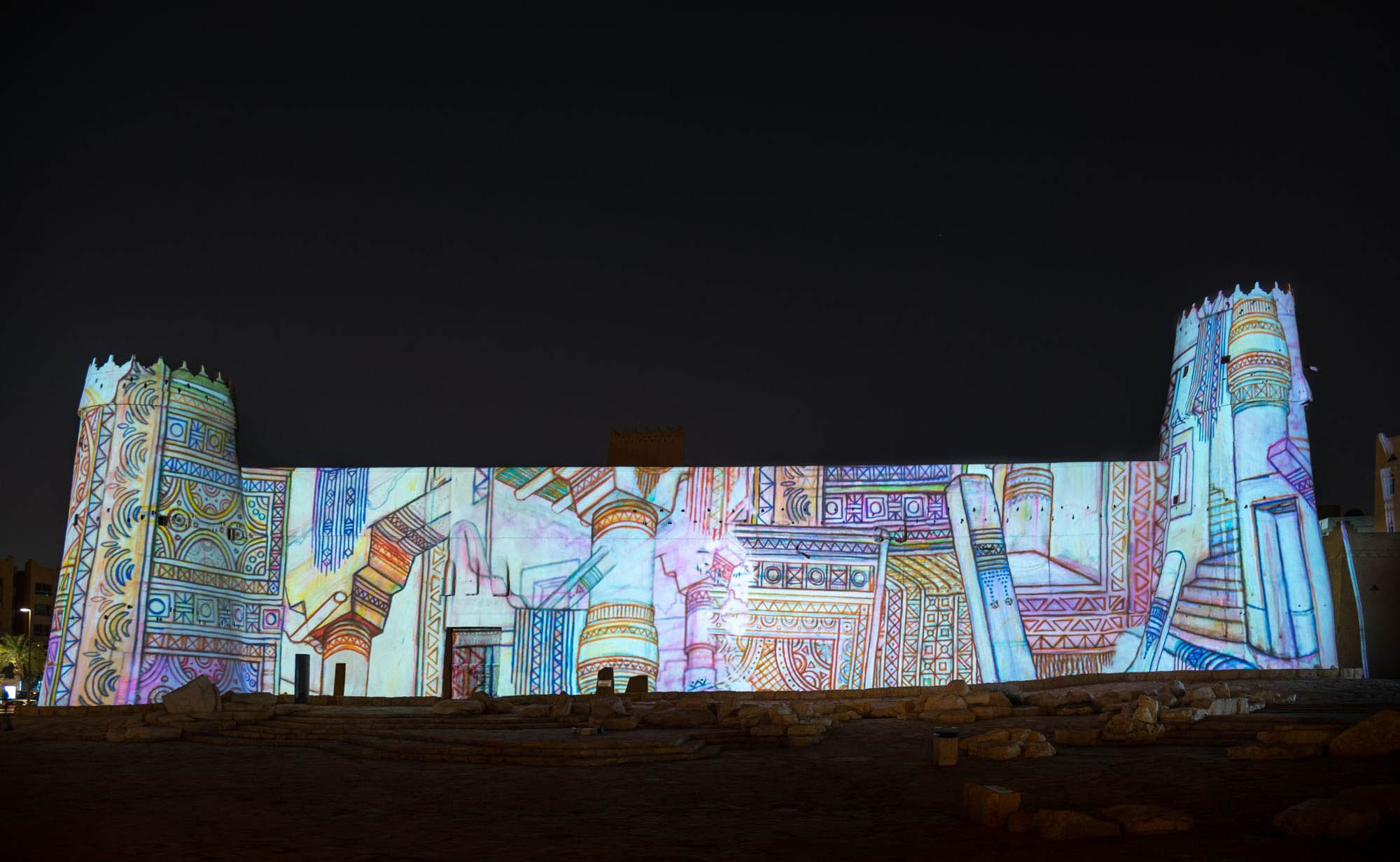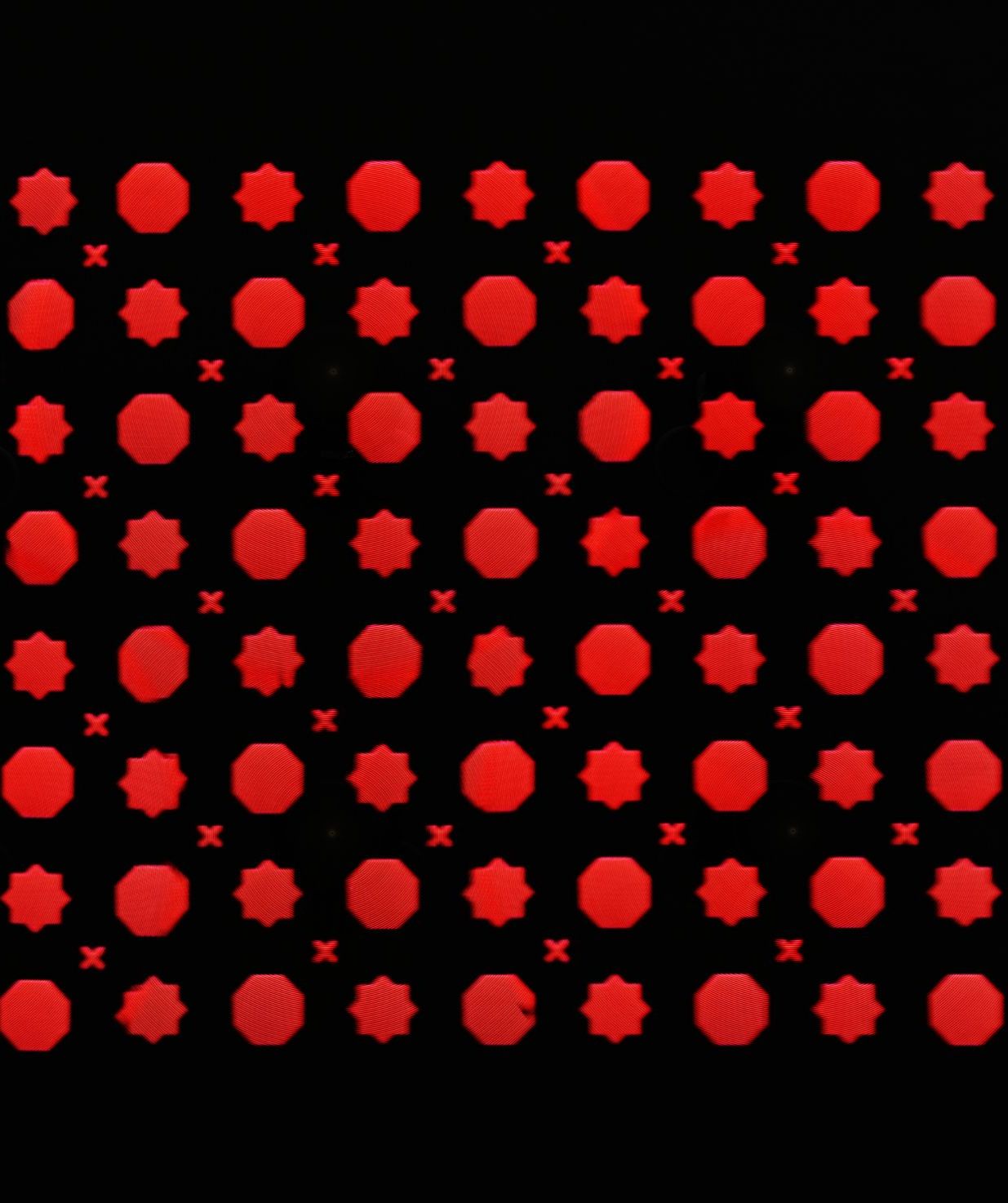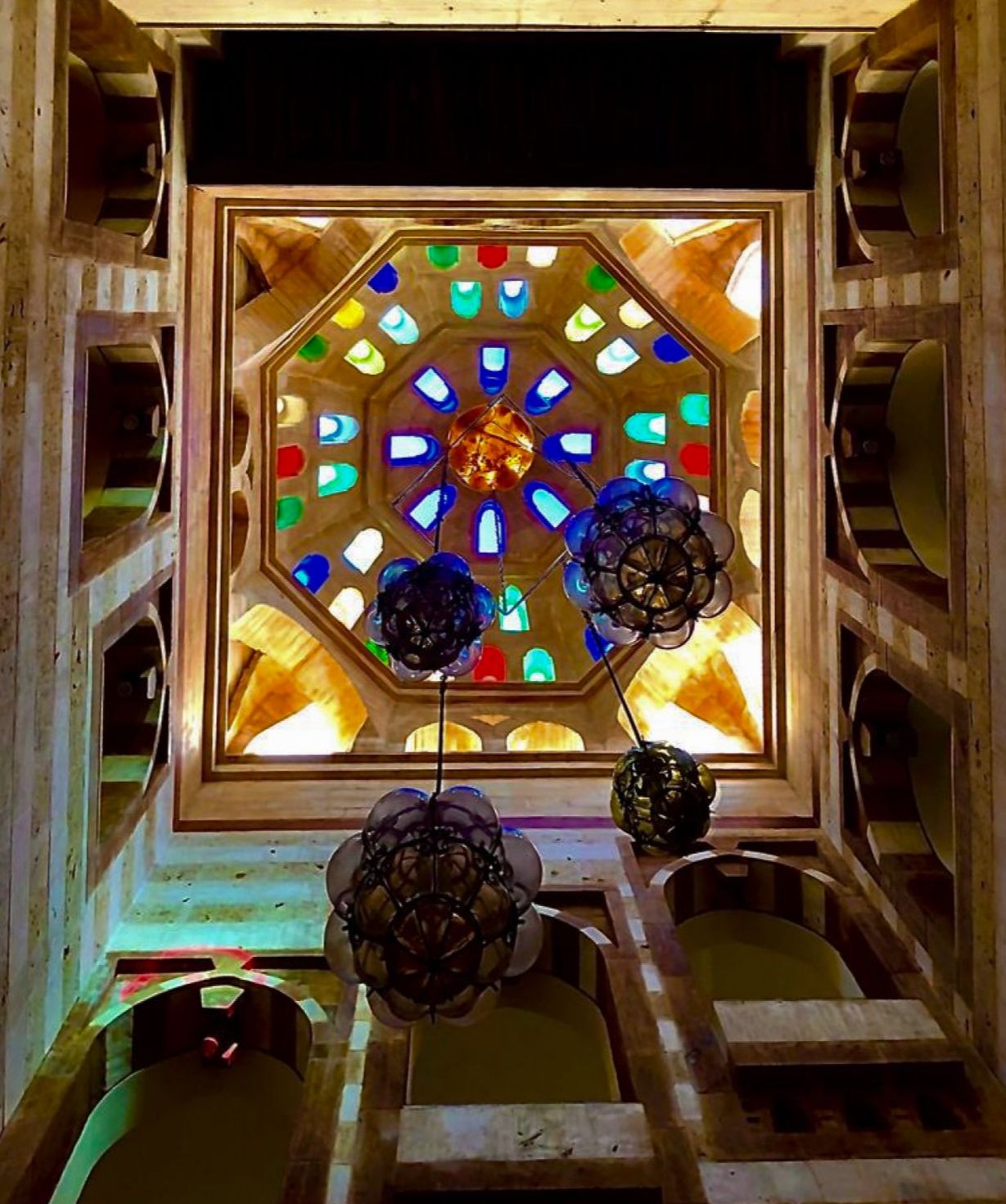The art of light, innovation and traditional Islamic art
‘The Guidance was born and all created things were illuminated / And the mouth of the ages (time) was all smiles and praise’ by Sarmad Kazem Al-Musawi, Iraq. 2011 Acrylic on Canvas. 180 x 180 cm From the Collection of UAE Ministry of Culture and Youth. Courtesy of UAE Ministry of Culture and Youth
“While you hone your craft and become better at it, don’t shy away from showcasing it to the world, art is not personal, art should be shared with the world. It’s a way of sharing, expressing and communicating, art sparks conversations and leads to dialogue….”
UAE Minister of Culture and Youth Noura Al-Kaabi, shares her thoughts and views with the Editor in Chief of Ithraeyat, Rym Al-Ghazal on art, the importance of perseverance, and the ever evolving Islamic art and its depth. H.E. Al Kaabi is one of UAE’s most dynamic ministers, breaking new grounds and milestones as she leads various art and creative initiatives. One of the prestigious initiatives she oversees, is the Al Burda Award.
Al Burda Award is a global platform launched in 2004 in the UAE to commemorate the birth anniversary of Prophet Muhammad.
“The name Al Burda comes from the thirteenth century poem by Imam Al Busiri, written in the praise of Prophet Mohammad [PBUH),”
said H.E Al Kaabi.
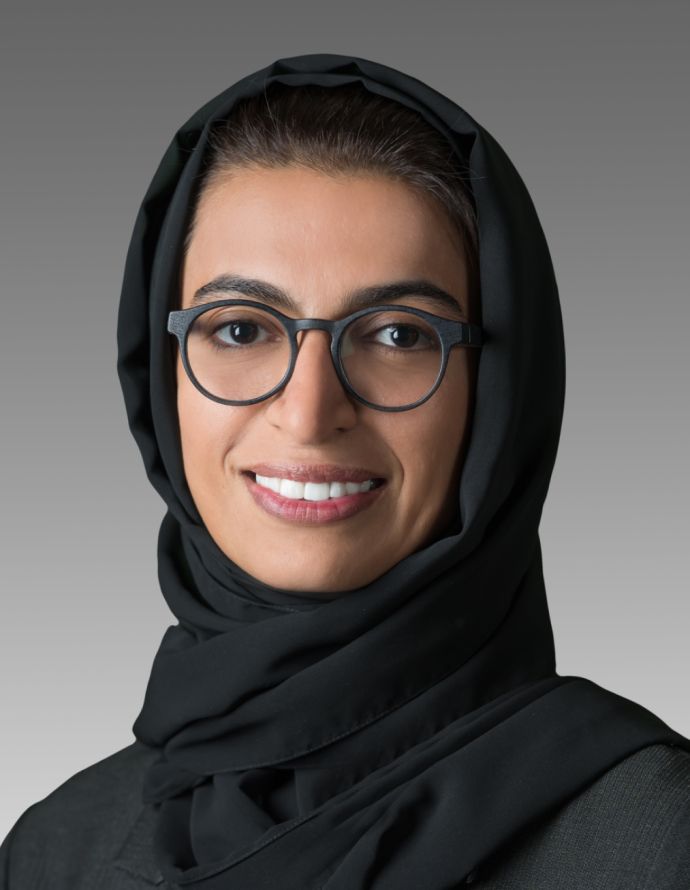
H.E Noura Al Kaabi, UAE Minister of Culture and Youth
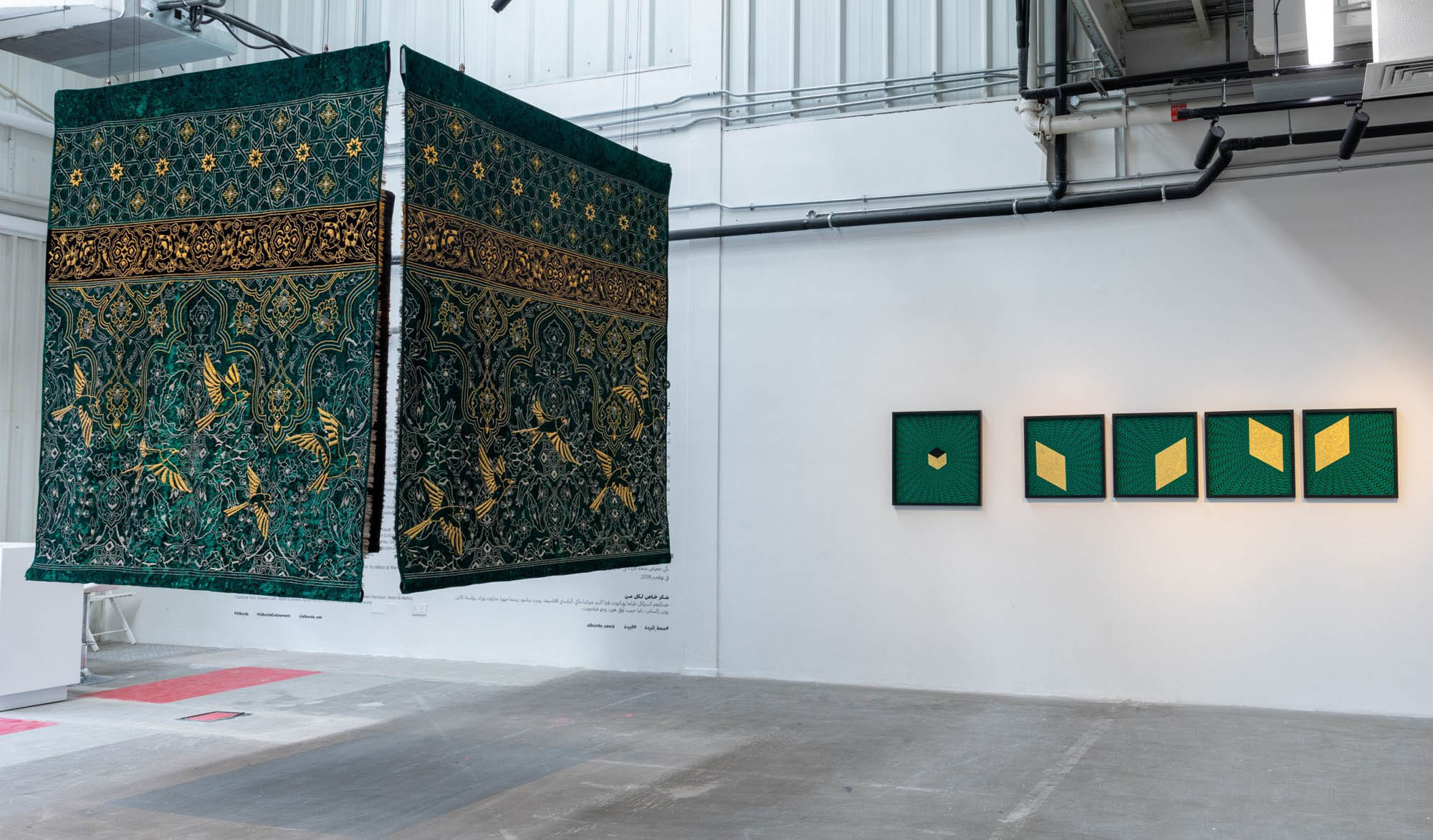
‘The Garden of Love is Green Without Limit,’ by Aisha Khalid from Pakistan. 2019 Five paintings: gouache and gold leaf on paper board 50.8 x 50.8 cm and 60.96 x 60.96 cm. From the Collection of UAE Ministry of Culture and Youth. Courtesy of UAE Ministry of Culture and Youth
The shape of the overall structure, the Islamic geometric configurations within and the ornate patterning all recall the Holy Kaaba and its kiswah (the cloth that covers the Kaaba) , while the green of the tapestries in the work takes inspiration from the dome of the Prophet’s Mosque in Medina . The structure also draws on the concept of the lush garden as a celebration of nature, beauty and serenity. Each panel features whirling birds in flight, as though in circumambulation around the tapestries. The panels differ both in the number and motion of the birds,
and just as birds fly over the Holy Kaaba, so too they do here. The paintings, which also incorporate the same colour scheme as the structure, recall the Islamic tradition of miniature painting and are presented to support the cube - like form. The spirituality within this piece is attributed to its actual assembly, the inclusion of a verse by the revered Sufi poet Jalaluddin Rumi and to the highly laborious, repetitive and meditative process involved in its creation - a spiritual act itself .

‘The Garden of Love is Green Without Limit,’ by Aisha Khalid from Pakistan. 2019 Five paintings: gouache and gold leaf on paper board 50.8 x 50.8 cm and 60.96 x 60.96 cm. From the Collection of UAE Ministry of Culture and Youth. Courtesy of UAE Ministry of Culture and Youth

‘Allah and His angels send blessings to the Prophet. O you who believe, call for blessings on him, and for greetings of peace,’ by Wissam Shawkat, Iraq. 2006 Ink on Ahar Paper 60 x 60 cm . From the Collection of UAE Ministry of Culture and Youth. Courtesy of UAE Ministry of Culture and Youth
it recognizes creativity and excellence in the practice of traditional Islamic disciplines, including Ornamentation, Classical and Modern Calligraphy, Nabati and Classical Arabic Poetry, and Arabic Typography - a new category added to the Award in a bid to encourage traditional expression by way of new technologies and interpretations.
“Al Burda conveys the values of Islamic aesthetics while upholding the virtues of tolerance and cultural harmony among people,” she said. “The award celebrates the diversity of Islamic culture and its artistic creativity and plays an important role in strengthening the UAE’s soft power. It shares the UAE’s cultural values and principles with the world while also strengthening its relations on a global level.”
discovered and rediscovered, there is always something unique showcased as part of the award’s exhibition and programs. Since its inception, 300 winners have been awarded and recognized for their outstanding creativity.
It’s heartening to see how the Award has achieved major successes in its past editions, giving a platform to talented creators and artists from the Arab and Islamic world while also welcoming talent from around the world,” said H.E. Al Kaabi.
“We are very proud to say that it is one of the richest international awards in the field of art and culture. This goes to show the UAE’s commitment to the cause and its belief in this art form. A total value of about AED 1.3 million is distributed among the winners in the four main categories.”
According to the Quran, light represents the sanctity of God, and it was one of God’s very first creations, so light holds a special place in Islamic art. Since Islamic art is nonrepresentational, light is used as a powerful element to communicate with the viewer. Even color in art is a depiction of the highly revered notion of light. In Islamic architecture as well, light plays a very significant role in designing the interiors of mosques and other buildings. It’s used very cleverly in architecture as a decorative medium and a way of expression. What’s remarkable about Islamic art is its diversity. There are numerous regional and cultural influences on Islamic art which have enriched it over the years. For example, the artistic offerings from the Far East have their own individual characteristics and are not the same as those from the Arab region, yet there is an underlying theme that unites these styles under the Islamic Arts umbrella. Within the Arab region itself, Islamic art has been influenced by various cultural and social elements that have added several dimensions and layers to it.
seeks to engage with the audience by inviting them to physically move towards and away from it and explore side to side. This allows the work to offer alternative perspectives, both visually and conceptually. A departure from the artist’s previous two - dimensional works, Focal Illusion employs themes of Islamic geometry in its use of multiple layers. Architecturally, it is constructed with the intention to manipulate our depth perception as well as concepts of light and dark, and visible versus invisible. The organization and repetition of the various elements of the piece support principles of Islamic geometry, while the colour scheme is representative of a moment of transition for the artist and one which has involved the move from one culture to another. Visually, it also calls to mind muqarnas, the honeycomb - like structures found in mosques. Carved and ornamented, they are highly mathematical structures, just as Focal Illusion is.

‘Focal Illusion,’ by Ebtisam Abdulaziz, from Sharjah, United Arab Emirates. 2019 Painted wood 144.78 7.62 × 172.8 × cm. From the Collection of UAE Ministry of Culture and Youth. Courtesy of UAE Ministry of Culture and Youth
This year’s Al Burda is indeed special. It’s the year of the 50 th and this year’s edition of Al Burda Festival and Award sums up the UAE’s cultural and artistic journey in the past several decades. Among other artworks, the exhibition will host art based, on the year of the 50th as a tribute to the nation. Moreover, the Festival and Award coincide with Expo 2020 Dubai, the world’s largest cultural event. The festival’s juxtaposition against the Expo makes it a perfect amalgamation of the old and the new and symbolizes how the UAE has preserved its artistic heritage while making strides in the modern world.
This is not all, the Expo gives the participants an opportunity to showcase their craft in the form of traditional art, calligraphy, poetry and typography on a world platform by way of Al Burda and the Expo gives it a further impetus. The Al Burda Award ceremony will be held in conjunction with the opening ceremony of the Arabic
Language Summit, and welcome the Ministers of Culture from the 22 member states of the Arab League Educational, Cultural and Scientific Organization (ALECSO).
This installation’s initial iteration began in 2015-2016 , when , using white ink on white paper , Nasser Al Salem wrote out a hadith by the Prophet Mohammed ( PBUH ) in which he describes Paradise : “ I have prepared for my righteous servants what no eye has seen , no ear has heard and no danger to the human heart .“ However, feeling this version of the hadith did not inspire enough time for contemplation, the idea of a green room was born.
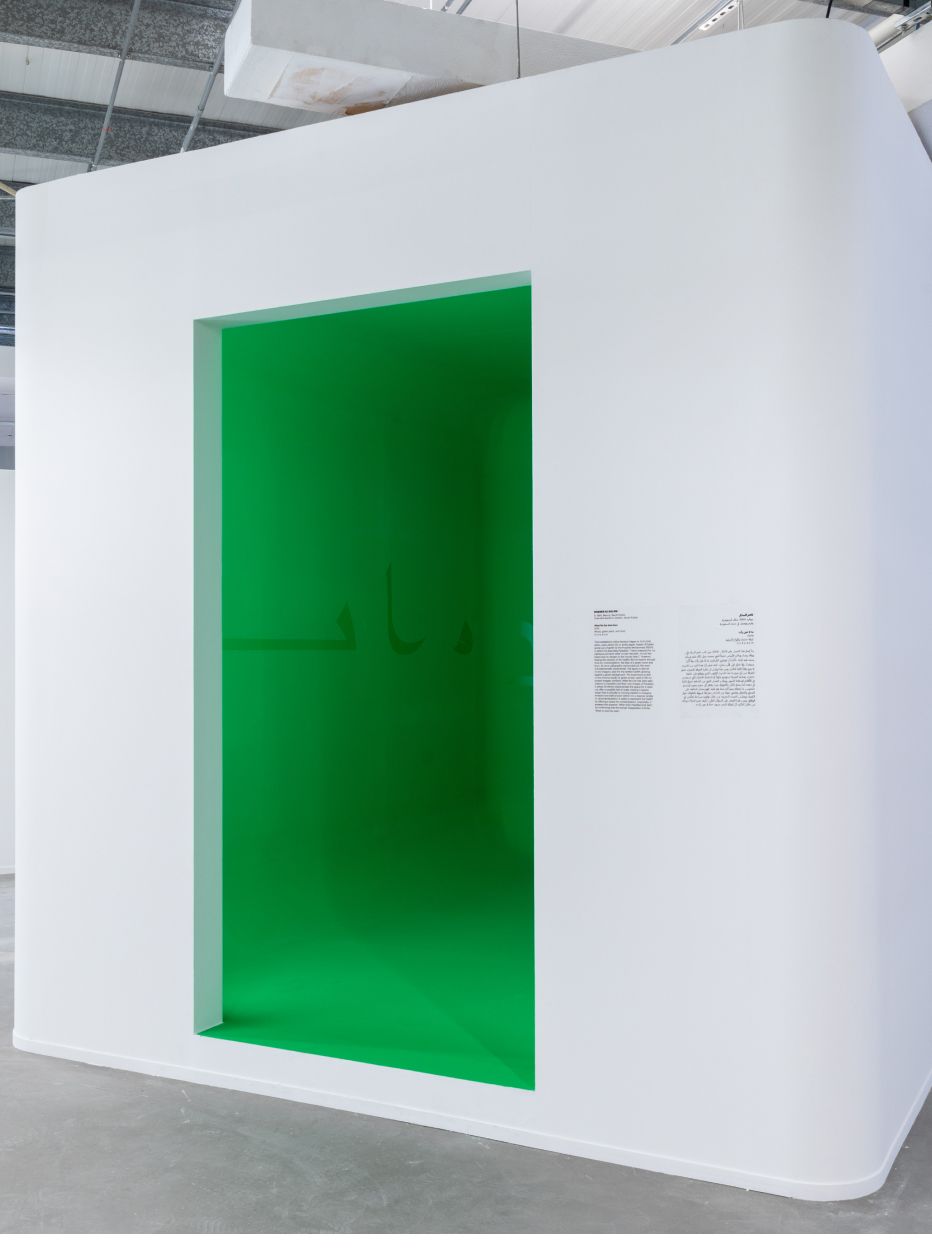
‘What No Eye Has Seen,’ by Nasser Al-Salem from Saudi Arabia. 2019. Wood, green paint, and vinyl 3 x 4 x 3.3 m. From the Collection of UAE Ministry of Culture and Youth. Courtesy of UAE Ministry of Culture and Youth
At once calligraphic and sculptural, the work is fundamentally experiential. The space is devoid of any imagery, save for the written hadith glowing against a green background. The experience is akin to the chroma studio or green screen used in film to project images: similarly, What No Eye Has Seen asks viewers to mentally cast their own images of Paradise. A sense of infinity characterizes the space for it
does not offer a tangible feel of scale, making it appear larger than it actually is. Forcing viewers to imagine, envision and walk around within it in a manner similar to circumambulation, it seeks to represent the hadith by offering a space for contemplation. Essentially, it answers the question” What does Paradise look like? by confirming that the human imagination is finite: What no eye has seen.
The Kingdom of Saudi Arabia and the UAE share a strong cultural bond. Both countries embrace their brotherly ties and relationship that continues to grow stronger. The Kingdom’s contribution to preserving Islamic art and culture is truly inspiring and sets an example for others to follow. Be it in the form of conserving calligraphy, Quran recitation, literature or art, the Kingdom of Saudi Arabia has been leading the way in conserving traditional art forms. A variety of institutions have been established throughout the Kingdom to preserve Saudi Arabia’s cultural heritage. The decision to bestow the Guest of Honor status, is based on this legacy and the Kingdom’s immense contribution to Islamic art. The Kingdom’s role in supporting and disseminating Islamic arts and culture is noteworthy - particularly its concerted efforts to register Arabic calligraphy on UNESCO’s List of Intangible Cultural Heritage. The Kingdom is currently observing the Year of Arabic Calligraphy, an initiative that highlights the discipline as an art in its own right and spreads the culture of its use.

H.E Noura Al-Kaabi with her adopted kitty, Burda, a famous resident of the Ministry of Culture and Youth.
(I met Burda and the kitty brings joy to whoever visits the ministry). Burda is a special cat that has long resided on the ministry grounds and brought us joy to us over the years. He was rescued and adopted by me. As we were launching Al Burda’s first iteration, the cat would respond to us when we called out Burda, hence the name. Burda indeed is there to welcome all who visit us at the ministry.
My advice is to continually strive to learn, research, respect substance over superficiality. Most importantly, be open and humble. Persevere and continue to learn. While you hone your craft and become better at it, don’t shy away from showcasing it to the world, art is not personal, art should be shared with the world. It’s a way of sharing, expressing and communicating, art sparks conversations and leads to dialogue. The social dimension of art is very strong. Therefore, it is important for young and upcoming artists to view art as a social phenomenon and bring about positive change in society and the world at large. Share your art, share your skill and showcase it. Go out there on world stage and promote your art. We as a nation are proud of what you create and we are here to support you.
I like all forms of art but what intrigues me more is modern art especially the work of regional artists. We have a lot of art from the region displayed in some of the galleries and museums in the UAE. It’s heartening to see the ever-evolving art scene burst with distinct shades of creativity. The international community is also taking notice of the burgeoning art movement in the region as more and more artists showcase their works on the global stage.
My motto evolves with the challenges at hand but what remains constant is the sense of duty and service that I have for my job, my nation and
my community. Everything that I do stems from this sense of duty and service, and I try to never lose sight of it.
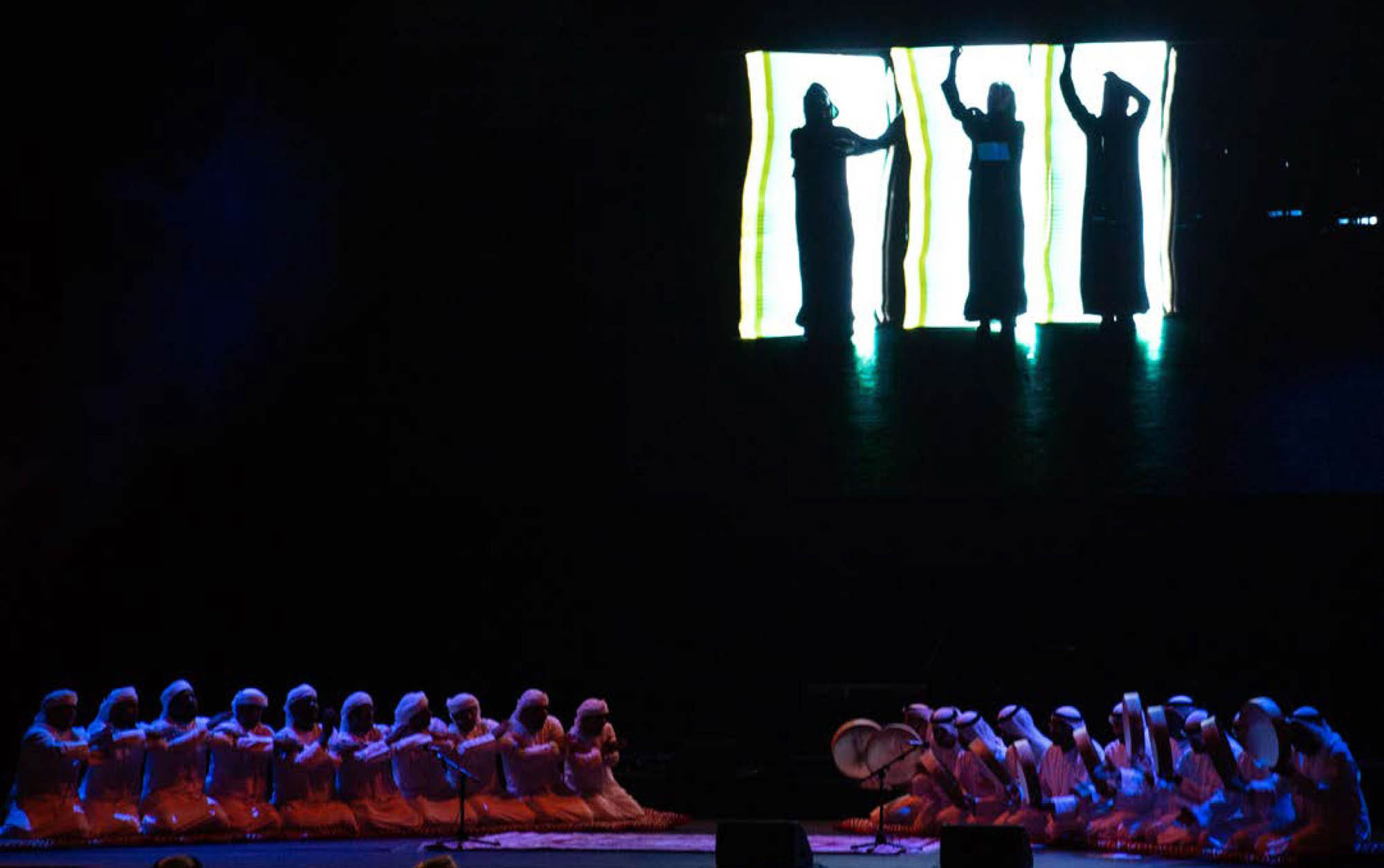
I strongly believe Islamic Art has a great future. If we go by the number of entries we receive for Al Burda Award, it is growing each year, which goes to show that our efforts in the field are in the right direction. There is interest in community to pursue traditional art forms, and this can be developed
further by proving the right grounds and incentives for upcoming artists. It’s a beautiful art form that needs to be showcased on world platforms.
Art and culture are deeply intertwined, and Islamic art is no exception. Like all other forms of art, Islamic art has cultural influences which makes it highly eclectic and diverse. A variety of local artistic traditions absorbed by Islam are the reason for a variety of styles united under the concept of Islamic art.
I like all forms of art but what intrigues me more is modern art especially the work of regional artists. We have a lot of art from the region displayed in some of the galleries and museums in the UAE. It’s heartening to see the ever-evolving art scene burst with distinct shades of creativity. The international community is also taking notice of the burgeoning art movement in the region as more and more artists showcase their works on the global stage.
As I said before art is a part of culture, it brings people together, it connects generations and adds a new dimension to life and makes it richer. Art has the ability to make connections and spark conversation and dialogue. An artist is not an isolated being he/she is connected with the world around.
Art transcends boundaries and connects peoples, cultures and nations. Art does not see any language or cultural barriers, which is why it has huge potential in bringing about change in the world.
